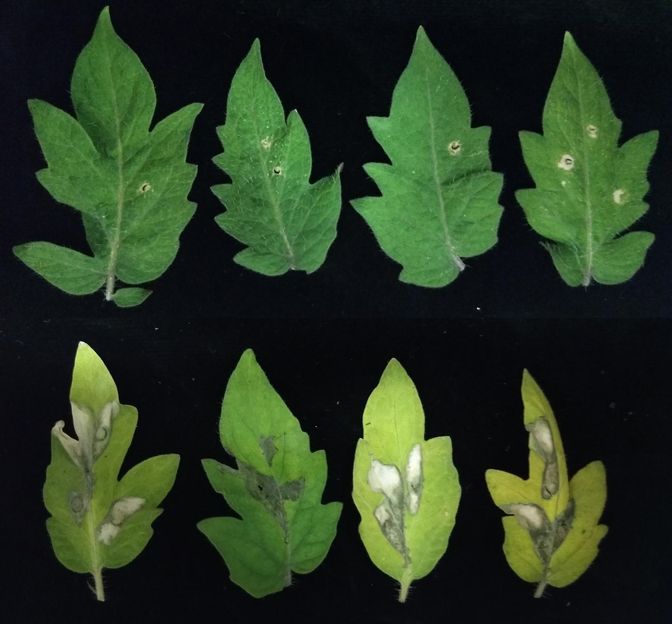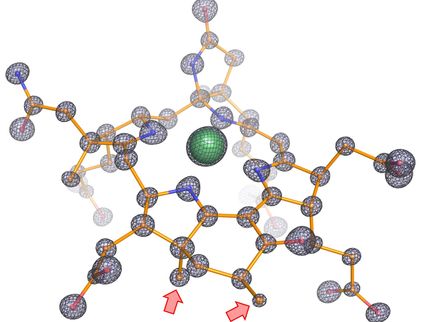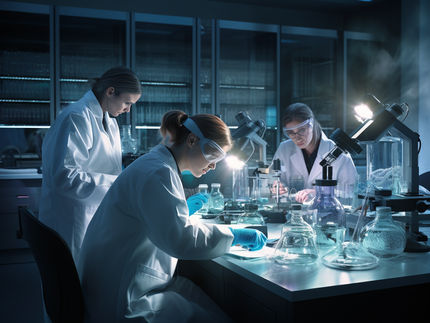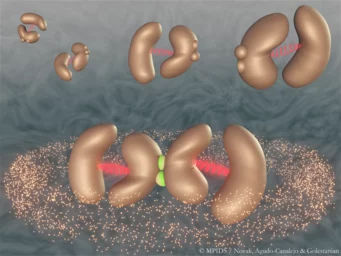Newly discovered biosynthetic pathway in bacteria recipe for drug discovery and production
microbes are master chefs of the biomolecular world; collectively, they harbor the ability to produce a vast array of unknown substances, some of which may have therapeutic or other useful properties. In searching for useful products, a team of chemists at Illinois have discovered a whole new class of microbial recipes.

Shown here are two photos sets of tomato plant leaves, the top set of leaves have no pseudomonas infection and the bottom set of leaves have pseudomonas infection.
Chi P. Ting
"The kind of reactions that these enzymes are doing are mind-boggling . . . when we first saw them, we were scratching our heads," said Howard Hughes Medical Institute (HHMI) Investigator Wilfred van der Donk, who led the study. "Then we had to painstakingly prove that the reactions we thought the enzymes were doing, are indeed carried out."
Van der Donk, who is also the Richard E. Heckert Endowed Chair in Chemistry, and his colleagues at Illinois collaborated with the laboratory of HHMI Investigator and University of California, Los Angeles Professor of Biological Chemistry and Physiology Tamir Gonen to confirm their findings, which were published in Science.
First author Chi Ting and van der Donk are members of a research team at the Carl R. Woese Institute for Genomic Biology that aims to discover new natural products--the potentially useful substances produced by microbes--by exploring their genomes, a strategy called genome mining.
"Genome mining allows you to start looking for compounds where you have absolutely no idea what they are going to be," van der Donk said. "Many labs in [our team] are trying to find new antibiotics by genome mining . . . you look for unusual things where we don't know what is being made, and then you try to make the compound in a friendly organism."
Cells use special chemical ingredients called amino acids to create proteins, which are the main structure and internal machinery of living things. Proteins are long chains made up of the twenty different types of amino acids; peptides are shorter chains. Some types of microbial natural products are formed from small peptides embellished with aftermarket chemical parts.
Proteins and most peptides are assembled by ribosomes, giant cellular machines that act like pastry chefs at a bakery. Following the recipes written in genes, ribosomes can link together any sequence of amino acids; ribosomes are efficient and versatile. Other peptide-based natural products are made by teams of specialized enzymes, which act like a home baker with a favorite recipe learned by heart--these enzymes don't follow a template, instead creating the same types of linkages and modifications over and over to make just one product.
"In natural product biosynthesis, both pathways are used to make natural products," van der Donk said. "And now we stumbled across something that has features from both."
The researchers made their unexpected discovery while examining a cluster of genes found in the bacterium Pseudomonas syringae, which infects plants. They had found that their cluster of genes included one that held the information for a peptide made by a ribosome, while another coded for an enzyme that could add another amino acid onto the peptide chain. The pastry chef was assembling a dough to make bread, but handing it over to a home baker to finish preparation.
"In retrospect it's just a really clever way of doing things," van der Donk said. "Having an enzyme that can do this to a pre-existing peptide means that now . . . you can use it as a scaffold and just keep making the natural product time and time again."
The type of synthetic process they discovered in Pseudomonas works this way because once the new amino acid is added to the peptide, it is modified in a series of steps and then broken off, returning the original ribosomally-created peptide back to the starting step. In this way, it is a bit like sourdough starter. As long as it remains active, it doesn't need to be recreated from scratch to make each subsequent batch of bread.
To fully describe their natural product and its synthesis, van der Donk's team wanted to get a better look at its structure. However, the molecule proved too unstable to use traditional techniques. The researchers reached out to Gonen, whose lab had recently applied a cutting-edge approach--using electron microscopy on flash-frozen microcrystals of purified substances--to the determination of the structures of small molecules.
"Once you've made the natural product, now you need to figure out what it is . . . Our collaborators wanted to show the utility of this method for an unknown molecule of natural origins," van der Donk said. "This was really a win-win situation for both labs. I think the whole natural products community probably will want to start using this technique."
Now that van der Donk and his team are aware of the existence of this alternative pathway for synthesis, they have already found other examples of similar mechanisms, including the production of an anti-tumor compound by a soil microbe. In addition to expanding the ability to recognize gene clusters that make promising natural products, the researchers are excited about finding new ways to put pathway to use.
"We're also excited as to how we might be able to use this for synthetic biology," van der Donk said. "Because the overhead, the amount of resources that have to go in to make a natural product, is fairly low here. You make this peptide, a few enzymes, and out comes rolling an anti-tumor compound . . . There's a lot of interest right now in engineering bacteria to have anti-cancer activity, and this is relatively low-hanging fruit with respect to making the organism make the molecules for you."





















































